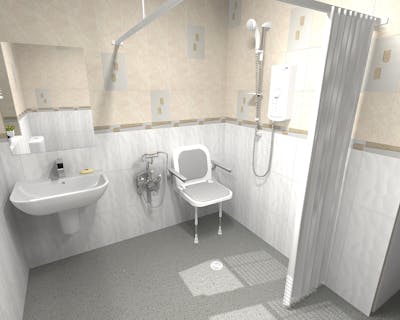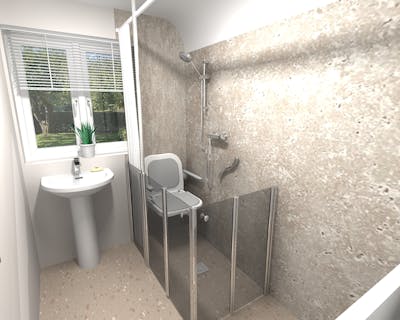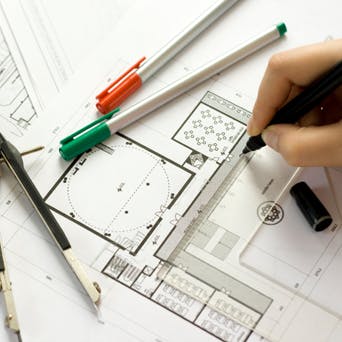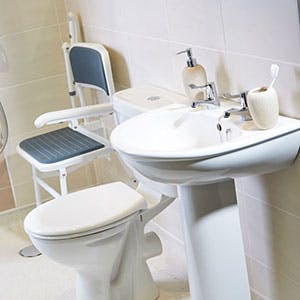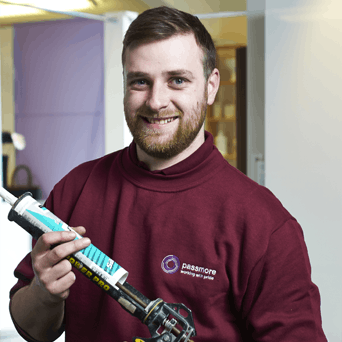Guide To Assisted Showering Solutions | More Ability
Published: 25 September 2015
There are currently over two million caregivers in the UK. This figure includes those who are classed as professional caregivers and those who aren't qualified but care for a friend, family member or loved one. Care of all types often requires assistance with bathing and providing additional support.
Assisted showering solutions are ideal for those in long term care settings whether that be at home, in residential care or a hospital environment. Offering superior levels of versatility, practicality and safety, disabled showers and disabled wet rooms are the ultimate assisted showering solutions.
Recent innovations mean that ‘live at home care’ is now more feasible. Not too long ago assisted showering solutions were kept for care homes and hospital settings. There simply wasn’t enough demand in the domestic market to make these products more readily available.
However, with independent living and multi-generation homes fast becoming an emerging trend as a result of people living longer and wanting to do so at home, developments within the market have been made to cater for this customer type.
In this article we’ve broken down what an assisted shower is, how to design an assisted shower, including additional safety features, and the benefits to installing one.
.jpg?auto=compress%2Cformat&cs=strip&ixlib=php-1.1.0&s=ddaa23c0b8c3030cdb10341c0273e139)
What Is An Assisted Shower?
An assisted shower is typically either a disabled shower or disabled wet room that consists of additional safety features, helping to provide additional bathing assistance. They allow for you or a loved one to be safely and comfortably washed by a carer, without the caregiver getting wet.
Both offering level access entry the main difference between a disabled shower and a disabled wet room is the visibility of the shower tray, which in a wet room is installed under the floor. It is also a personal preference in wet room design whether you incorporate a partition to keep water within the wet area.
.jpg?auto=compress%2Cformat&cs=strip&ixlib=php-1.1.0&s=33c11ca4fd31561d27684b52c2ac1a3e)
How To Design An Assisted Shower.
The bathroom is considered to be one of the most dangerous rooms within the home. Whether you opt for a disabled shower or disabled wet room, additional safety features can be installed to make the showering experience more comfortable. Such safety features include:
Half Height Bi-Fold Shower Doors.
Half height bi-folding doors keep water in the showering area whilst allowing the user to be bathed comfortably, without the carer getting wet. They are one of the most important features when considering how to design an assisted shower.
As mentioned above, we also recommend the installation of a shower curtain, as it provides additional privacy for the person being bathed.
Non-Slip Shower Tray.
If you decide a disabled shower is the best assisted shower option for you or a loved one, make sure the shower tray is coated in an anti-slip material for increased safety while in use.
Anti-Slip Flooring.
Anti-slip flooring, typically vinyl, will help prevent any slips, trips or falls. A disabled wet room would have this as standard, however we would always encourage this as a flooring option in any assisted shower design.
Fixed Cushioned Shower Seat.
A fixed and cushioned shower seat will provide additional support when bathing. It allows the user to comfortably shower whilst sitting down and is suitable for those who struggle to stand up for long periods of time.
Wall Boards
We often recommend the installation of wall boards in assisted shower room designs as they are hard wearing, easy to clean and generally low maintenance.
Fitted Grab Rails
Fitted grab rails should be directly installed in the assisted shower as well as situated around the rest of the suite, to provide additional support whilst standing, sitting and navigating around the room. They also assist with independent bathing.
Adjustable Shower Head (Riser Rail)
The installation of an adjustable shower head is a practical option for multi-generational bathrooms, or as part of adapting the home for an elderly parent. Where people of varying heights and abilities will be using the shower, they allow the assisted shower head height to be raised or lowered to the most comfortable height for the user, making them adaptable whether the shower is used seated or standing.

Further Assisted Shower Room Adaptations.
Alongside the installation of an assisted shower there are further adaptations you can make to your suite to increase a user’s safety and their comfort whilst in use.
Auto Bidet Wash Dry Toilets
Auto bidet wash dry toilets help those who struggle with mobility to use the toilet more independently. They clean and dry the user’s intimate area with water and air and are controlled by a button or remote control.
Rise And Fall Basins
The installation of a rise and fall basin allows the position of the basin to be adjusted to a more suitable height for the user. For those that are unable to bend, it would facilitate the basin to be used whilst stood upright however can also be lowered for those that require use while seated.
Typically wall hung, a wheelchair accessible basin can also be installed where the basin is fixed to a permanent accessible height for seated use.
Benefits Of An Assisted Shower.
There are many benefits to installing an assisted shower that directly impacts the experience that both the care giver and user receive. To summarise the three main key points that the design and installation of an assisted shower provides include:
1. A more comfortable and dignified bathing experience
2. Additional support and ease of use for the caregiver
3. Additional safety and ease of use for the elderly and or disabled
At More Ability, we specialise in the full design and installation of an assisted shower and wider shower room suite. If you wish to find out more information on how you and or a loved one can benefit from an assisted shower call a friendly member of our expert team or book a free design appointment online.
Share this Post


.jpg?auto=compress%2Cformat&cs=strip&ixlib=php-1.1.0&s=ddaa23c0b8c3030cdb10341c0273e139)
.jpg?auto=compress%2Cformat&cs=strip&ixlib=php-1.1.0&s=33c11ca4fd31561d27684b52c2ac1a3e)

.jpg?auto=compress%2Cformat&cs=strip&fit=clip&h=400&ixlib=php-1.1.0&w=400&s=9fa3862dd64550f902ce5099d00692fb)
